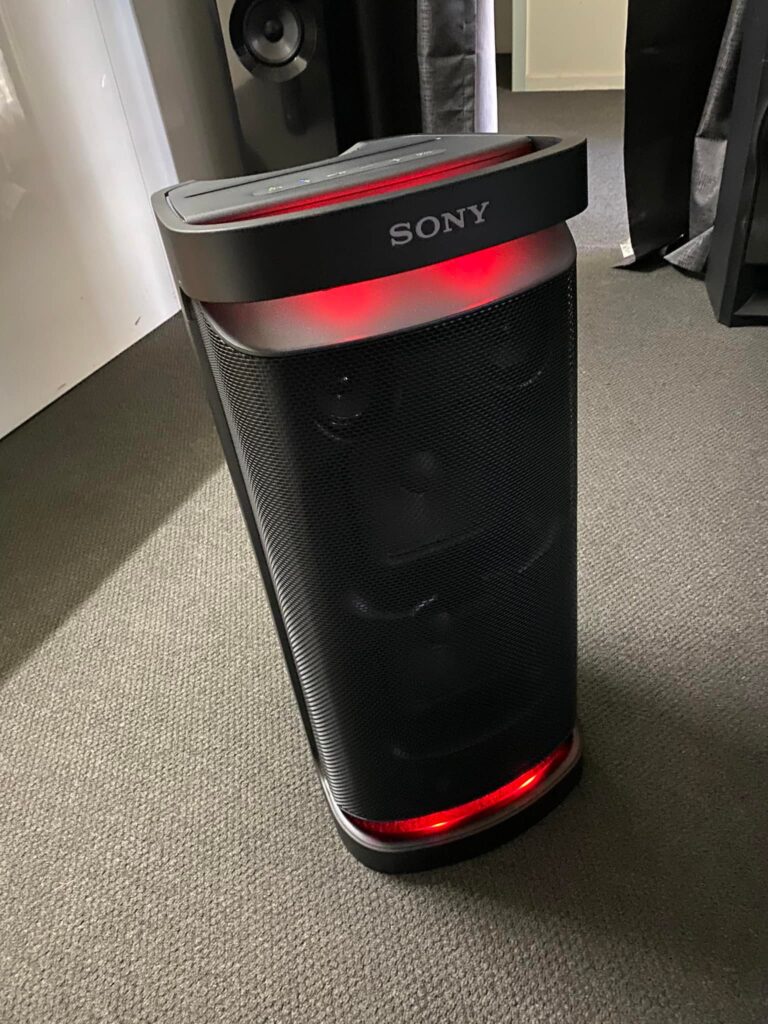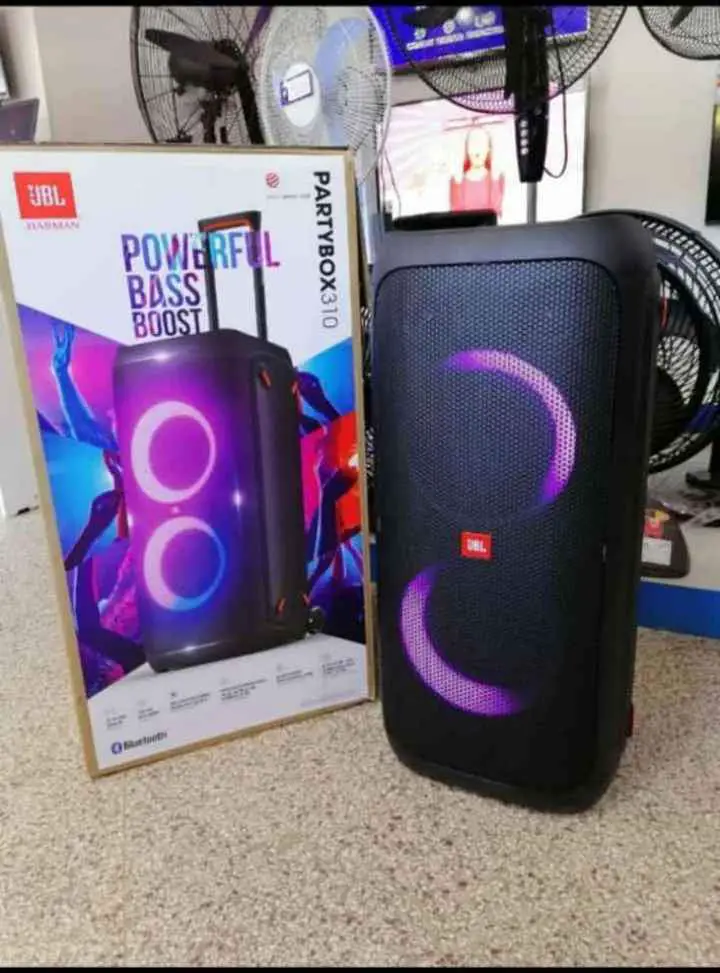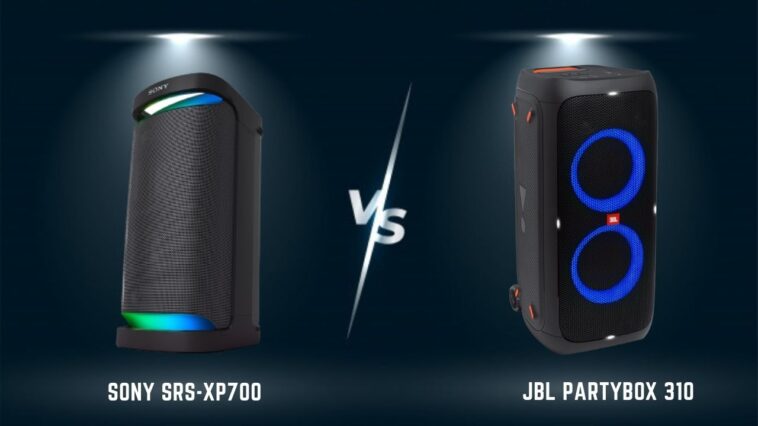Table of Contents
The speaker market is quickly evolving and we are seeing new products come to the market all the time. With so many different options, it can be difficult to decide which speaker is right for you. I will break down some of the best Bluetooth speaker options on the market today and discuss what makes them different from one another.
Sony SRS-XP700 Vs JBL Partybox 310: Comparison Chart
| Speaker | Sony | JBL |
| Type | Tower | Tower |
| Bluetooth | v5.1 | v5.1 |
| Weight | 16.5kg | 17.2kg |
| App | YES | YES |
| Connect+ | YES with any sony speaker | Yes, only with JBL 310 |
| Ports | 2 USB A, 3.5mm | 1 USB A, 3.5mm |
| Charging Time | 10min-3hrs playback 3 hrs to full charge | 20min-2hrs playback 4-5 hrs to full charge |
Sony SRS-XP700 Vs JBL Partybox 310: Detailed Analysis
When it comes to portable Bluetooth speakers, there are a lot of different options to choose from. But if you’re looking for the best sound quality and features, then the Sony SRS-XP700 and the JBL Partybox 310 are two of the best options on the market. The Sony SRS-XP700 is a high-end speaker that offers great sound quality and features. It has a built-in subwoofer for deep bass, and it also has NFC connectivity for easy pairing with your devices. The JBL Partybox 310 is also a high-quality speaker
Design-
Let’s start with the appearance of these speakers. Both of these speakers have primarily plastic casings, which can be scratch magnets if you plan on carrying them around. On the front, they both have metal grills. However, both of these speakers have an IPX4 certification, which means that if you leave either of these speakers outside overnight or if it begins raining during your party, a small bit of water won’t harm them. Both of these speakers stand around two and a half feet tall and weigh about 40 pounds each. They now both feature built-in carrying handles, making them much easier to transport.
The partybox 310’s first distinguishing feature is that it comes with built-in wheels and a retractable handle. So you roll this speaker instead of carrying it. Now, regardless of how much you deadlift or squat at the gym, being able to just roll the Partybox 310 around is a big convenience that the Sony XP700 lacks. Finally, I’d like to point out that the XP700 is not compatible with a speaker stand, although the Partybox 310 is.
Sound Quality-

Let’s talk about how to use these speakers to listen to music. The Partybox 310 has a pair of frontward firing woofers and a pair of tweezers for speaker setup. The XP700, on the other hand, contains a pair of forward-firing woofers as well as four tweeters. There are three in the front, which you can see clearly here, and one in the back, which will bounce sound off the wall if you set this speaker against a wall. On the XP700, however, not all of these tweeters are always active. If you put this speaker down like this, it will utilize these two tweeters, and if you set it up correctly, it will use these two tweeters.
as well as the one at the back. However, whether you have these two speakers resting flat or standing up straight, you still have your left channel and your right channel. If you set these speakers up correctly, they won’t transform into mono speakers. Now, let’s talk about giant bass and bass boost. If you’re planning to listen to music on the XP700, make sure you have mega bass turned on, because otherwise this speaker will sound flat… The Partybox 310, on the other hand, sounds great even with the bass boost option set on. The bass boost, on the other hand, has two levels.
MUST-READ: 12 Best Laptop For CSE Students!
Connectivity and Ports
When it comes to Bluetooth communication, the XP700 uses version 5.0, whereas the Partybox uses version 5.1. However, both of these speakers may be linked to two devices at the same time, allowing you and a friend to simultaneously be DJs. When watching videos, they both have minimal latency, but when it comes to audio codecs, the Partybox only supports SBC and AAC, whilst the XP700 supports SBC, AAC, and LDAC.
Let’s start with the ports on these speakers. First and foremost, both of these speakers offer two quarter-inch mic inputs, which might be useful for those who wish to conduct karaoke or organize small gatherings. However, I like the partybox here since you can modify the bass, treble, and echo of your microphone straight from the speaker’s control panel, and there are even some preset sound effects.
While we’re on the subject of this control panel… I’d like to note out that the Partybox 310’s panel lights up, whilst the XP700’s does not. And, like the wheels on the Partybox 310, this is a tiny luxury that the Partybox 310 lacks.
The USB A ports on these speakers are next; the Partybox 310 only has one, but the XP700 has two. Nonetheless, if you’re out and about, you can charge your own gadgets and listen to music from a USB drive on any of these speakers. I believe it’s fantastic that each of these speakers includes USB A connectors.
Following that, each of these speakers includes standard 3.5-millimeter audio connectors, allowing you to utilize either of these speakers with a wired connection.
ALSO READ: Sony WH-1000XM4 vs Surface Headphones 2: Comparison
Special Functions-

You can only wirelessly link it with one other Partybox 310, the same as the Partybox 310. You can’t connect it to any other party boxes, not even a Partybox 300… You also can’t connect it to any of JBL’s smaller party boost speakers. However, as previously stated, the Partybox 310 does feature audio out connection, allowing you to daisy chain it to any other speaker. So there you have it. As I’ve previously stated, I wish JBL would add a party boost to their partybox speakers.
Overall, the key advantage of Sony’s Party Connect is that you can combine your bigger box speakers with your smaller, more portable speakers, whereas JBL cannot.
Battery-
But first, let’s take a look at the battery life of these speakers. Now, the XP700 has a battery life of 25 hours, whilst the Partybox has a battery life of 18 hours. However, the XP700’s advertised battery life of 25 hours is with the device set to 25% volume, with the light feature turned off, but with the mega bass feature turned on. In contrast, the Partybox is set to play at 50% volume, with the light feature turned off, and the Bass Boost turned off.
Portability-
Both of these speakers stand around two and a half feet tall and weigh roughly 40 pounds. They each feature built-in carrying handles, so moving them about is no longer a problem. The partybox 310’s first key distinguishing feature is that it has built-in wheels and a retractable handle. So, rather than lugging this speaker, you roll it.
Sony SRS-XP700 Vs JBL Partybox 310: Quick Result
| Speaker | Sony SRS-XP700 | JBL Partybox 310 |
| Dimension | 12.32 x 27.28 x 14.44″ / 31.29 x 69.29 x 36.68 cm | 12.83 x 27.09 x 14.49″ / 32.6 x 68.8 x 36.8 cm |
| Bluetooth | V5.1 | V5.1 |
| Waterproofing | IPX4 | IPX4 |
| Battery | 18-20hrs | 20-22hrs |
Sony SRS-XP700 Vs JBL Partybox 310: Final Verdict
We hope this article has helped you decide which portable Bluetooth speaker is better for your needs. The JBL partybox 310 is a great option for those who are looking for powerful sound, while the Sony srs-xp700 is perfect for those who want a speaker with a sleek, compact design. Ultimately, the choice is up to you, but we hope this article has helped you make an informed decision. Thanks for reading!
ALSO READ: Ultimate Ears Wonderboom 2 Vs Megaboom 3 Comparison!





